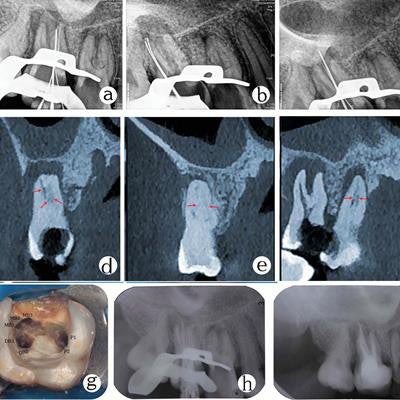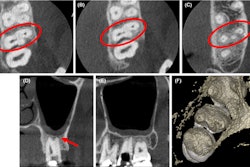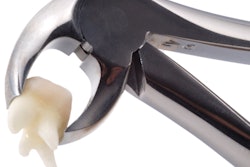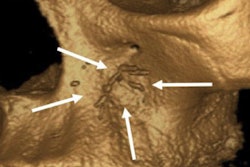
Imaging helped guide the dental treatment of a woman with two molars that had at least six abnormal root canals due to taurodontism, a tooth development disorder. The case report was published on August 30 in BMC Oral Health.
The patient's maxillary first molar had six root canals and her ipsilateral upper jaw molar had seven. Most molars have two to four canals. There are 14 known reports of molars with at least six canals, and only three of those cases involve molars with seven canals, according to the authors.
In the case described in the report, the use of cone-beam computed tomography (CBCT) and a dental operating microscope increased clinicians' knowledge and awareness of tooth complexities and helped dredge the root canals, they wrote.
"Proper diagnosis and careful clinicoradiological examination are necessary, and it is essential to reinforce the knowledge of the rare morphology of root canals for clinicians," wrote the group, led by Drs. Yao Lin and Yan Xiang from the endodontics department of Stomatological Hospital of Xiamen Medical College in China.
 X-ray of tooth #16 shows (A) mesiobuccal, (B) distobuccal, and (C) palatal roots. A CBCT scan shows canal configuration in the (D) mesiobuccal root, (E) distobuccal root, and (F) palatal root canals. (G) Image of access opening showing six root canal orifices. (H) Image of master cone fit. (I) Postobturation radiograph. All images courtesy of Lin, Xiang, et al. Licensed under CC BY 4.0.
X-ray of tooth #16 shows (A) mesiobuccal, (B) distobuccal, and (C) palatal roots. A CBCT scan shows canal configuration in the (D) mesiobuccal root, (E) distobuccal root, and (F) palatal root canals. (G) Image of access opening showing six root canal orifices. (H) Image of master cone fit. (I) Postobturation radiograph. All images courtesy of Lin, Xiang, et al. Licensed under CC BY 4.0.Potential for treatment failures
To successfully complete endodontic procedures, clinicians must understand each patient's root canal anatomy and the morphology of the teeth. If canals are not sealed completely or some are left untreated, endodontic treatments often fail.
Taurodontism is linked to developmental or genetic disorders and affects multirooted teeth, such as molars. It is identified by an elongated pulp chamber due to apical displacement of the pulpal floor. The condition can make endodontic treatment more challenging; in the general population, the prevalence of taurodontism is 0.5% to 5%.
Fortunately, CBCT scans effectively analyze root canal anatomy by visualizing multiple orientations in very thin slices without disturbing the overlapping structures, the authors wrote. The combined use of a dental operating microscope with CBCT aids identification of and work on root canals in the upper molars.
In the current case, a 35-year-old woman was referred for root canal treatment after repeated episodes of swelling in the upper right posterior maxilla related to teeth #16 and #17 for three months. Also, a general dentist believed the woman had a second root canal in her mesiobuccal root but couldn't locate it, according to the authors.
 X-ray of tooth #17 shows (A) mesiobuccal, (B) distobuccal, and (C) palatal roots. A CBCT scan shows canal configuration in the (D) mesiobuccal root, (E) distobuccal root, and (F) palatal root canals. (G) Image of root canal orifices. (H) Image of master cone fit. (I) Postobturation radiograph.
X-ray of tooth #17 shows (A) mesiobuccal, (B) distobuccal, and (C) palatal roots. A CBCT scan shows canal configuration in the (D) mesiobuccal root, (E) distobuccal root, and (F) palatal root canals. (G) Image of root canal orifices. (H) Image of master cone fit. (I) Postobturation radiograph.On radiographs, clinicians could see the pulp chamber was extended, the pulp floors showed apical displacement, the roots were short, and both teeth showed periapical translucency. The teeth were diagnosed as showing symptomatic apical periodontitis and mesotaurodonts. Mesotaurodontism is a classification of taurodontism in which the teeth are notably larger in size and have shortened roots and an enlarged pulp chamber.
Root canal therapy was recommended. Using a dental operating microscope, the dentist removed residual decay and prepared the access opening. Three orifice openings were identified in the pulp chamber. A closer look revealed complex patterns in both molars. An extra root canal orifice was concealed approximately 2 mm to 3 mm under the prepared canal orifice of the mesiobuccal and palatal canals in tooth #17.
CBCT scans gave a better view of the teeth and verified the findings. Clinicians prepared six canals in tooth #16 with two in the mesiobuccal root, two in the distobuccal root, and two in the palatal root. They also prepared seven canals in tooth #17: three in the mesiobuccal root, two in the distobuccal root, and two in the palatal root, the authors noted.
 CBCT shows the (A) six root canals of tooth #16 and three mesiobuccal root canals, (B) two palatal root canals of tooth #17, and (C) two distobuccal root canals of tooth #17.
CBCT shows the (A) six root canals of tooth #16 and three mesiobuccal root canals, (B) two palatal root canals of tooth #17, and (C) two distobuccal root canals of tooth #17.During root canal preparation, they could see that two of the canals in the mesiobuccal root of tooth #17 were joined together. The canals in the palatal roots were separated in the middle of the palatal root and met together in the third apical. X-rays and an electronic apex locator were used to determine the roots' working lengths. The preparation was completed, and the access cavity was sealed with temporary filling.
A week later, the root canals were completed, the access cavity was temporarily restored, and the woman was sent to undergo coronal rehabilitation, according to the authors.
Brush up on root canal variations
Because complex maxillary molar variations in patients are possible, clinicians need to be aware of the rare morphology of root canals, the authors wrote.
"A number of canals and morphologically abnormal canals can exist in a tooth with vital pulp; thus, proper diagnosis and careful clinicoradiological examination are required," they concluded.




















